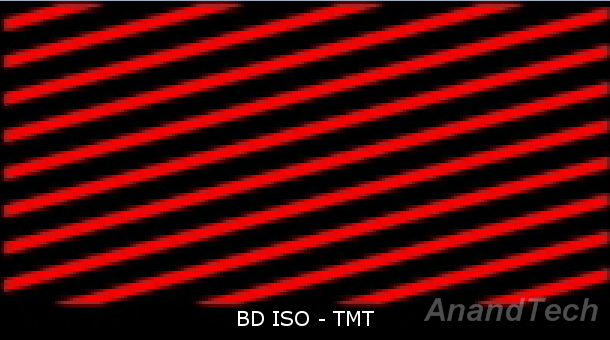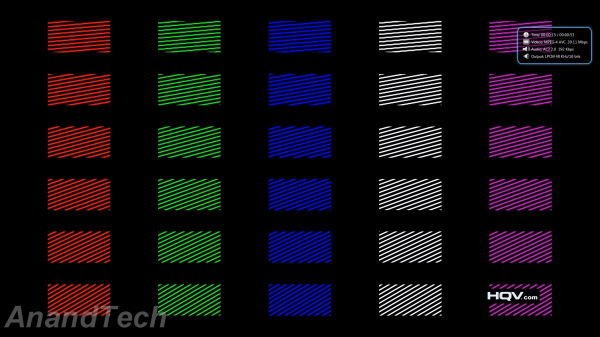AMD Radeon HD 7750 & Radeon HD 7770 GHz Edition Review: Evading The Price/Performance Curve
by Ryan Smith & Ganesh T S on February 15, 2012 12:01 AM EST- Posted in
- GPUs
- AMD
- HTPC
- GCN
- Radeon HD 7000
HQV 2.0 Benchmarking
HTPC enthusiasts are often concerned about the quality of pictures output by the system. While this is a very subjective metric, we have decided to take as much of an objective approach as possible. Over the last year or so, we have been using the HQV 2.0 benchmark for this purpose.
The HQV 2.0 test suite consists of 39 different streams divided into 4 different classes. The playback device is assigned scores for each, depending on how well it plays the stream. Each test was repeated multiple times to ensure that the correct score was assigned. The scoring details are available in the testing guide on the HQV website.
We first played back the benchmarking clips off the Blu-ray, but the scores recorded below are for standalone M2TS playback using CyberLink PowerDVD 12. Our take is that it is standalone files (such as those taken using consumer camcorders and smartphones) which require video post processing more than the already carefully transferred Blu-ray content. If certain driver post processing features are available only for Blu-ray playback, then, it is as good as not being available for consumers to take advantage.
In the table below, we indicate the maximum score possible for each test, and how much the 7750 was able to get with AMD's Catalyst 12.1-based launch drivers.
| AMD 7750 : HQV 2.0 Benchmark | ||||
| Test Class | Chapter | Tests | Max. Score | Radeon HD 7750 |
| Video Conversion | Video Resolution | Dial | 5 | 5 |
| Dial with Static Pattern | 5 | 5 | ||
| Gray Bars | 5 | 5 | ||
| Violin | 5 | 5 | ||
| Film Resolution | Stadium 2:2 | 5 | 5 | |
| Stadium 3:2 | 5 | 5 | ||
| Overlay On Film | Horizontal Text Scroll | 5 | 5 | |
| Vertical Text Scroll | 5 | 5 | ||
| Cadence Response Time | Transition to 3:2 Lock | 5 | 5 | |
| Transition to 2:2 Lock | 5 | 5 | ||
| Multi-Cadence | 2:2:2:4 24 FPS DVCam Video | 5 | 5 | |
| 2:3:3:2 24 FPS DVCam Video | 5 | 5 | ||
| 3:2:3:2:2 24 FPS Vari-Speed | 5 | 5 | ||
| 5:5 12 FPS Animation | 5 | 5 | ||
| 6:4 12 FPS Animation | 5 | 5 | ||
| 8:7 8 FPS Animation | 5 | 5 | ||
| Color Upsampling Errors | Interlace Chroma Problem (ICP) | 5 | 2 | |
| Chroma Upsampling Error (CUE) | 5 | 2 | ||
| Noise and Artifact Reduction | Random Noise | SailBoat | 5 | 5 |
| Flower | 5 | 5 | ||
| Sunrise | 5 | 5 | ||
| Harbour Night | 5 | 5 | ||
| Compression Artifacts | Scrolling Text | 5 | 5 | |
| Roller Coaster | 5 | 5 | ||
| Ferris Wheel | 5 | 5 | ||
| Bridge Traffic | 5 | 5 | ||
| Upscaled Compression Artifacts | Text Pattern | 5 | 3 | |
| Roller Coaster | 5 | 3 | ||
| Ferris Wheel | 5 | 3 | ||
| Bridge Traffic | 5 | 3 | ||
| Image Scaling and Enhancements | Scaling and Filtering | Luminance Frequency Bands | 5 | 5 |
| Chrominance Frequency Bands | 5 | 5 | ||
| Vanishing Text | 5 | 5 | ||
| Resolution Enhancement | Brook, Mountain, Flower, Hair, Wood | 15 | 15 | |
| Video Conversion | Contrast Enhancement | Theme Park | 5 | 5 |
| Driftwood | 5 | 5 | ||
| Beach at Dusk | 5 | 5 | ||
| White and Black Cats | 5 | 5 | ||
| Skin Tone Correction | Skin Tones | 10 | 7 | |
| Total Score | 210 | 193 | ||
We were not able to match what AMD claimed. In all probability, the difference is in the chroma upsampling scores. We already covered this in the Llano review. To recap, the image below is a screen capture while playing the HQV benchmark clip from a Blu-ray ISO on the AMD A8-3850. Note that the light red fringes along the edgs are uniform and extend to the right and the left before tapering off.

Now, let us look at the screen capture when the M2TS is played back using PowerDVD 12 on the Radeon HD 7750.
Zoom into the red stripes on the third row (in the original screenshot) and you can see for yourself that we have some ghost samples extending above and below the actual line of pixels. The screenshot is not at the exact timestamp as that of the Llano sample reproduced above, but the reader should be able to get a general idea of the problem we are hinting at. Readers interested in finding out more about the source of this problem should read up this excellent piece to get more information.
We notified AMD about this issue during the Llano review, but action doesn't seem to have been taken even after 6 months on what is clearly a driver issue. Note that we are not using MPC-HC (which might introduce its own errors in the renderer) in this case, but a standard off-the-shelf commercial player in CyberLink PowerDVD 12. Hopefully, AMD wakes up to this issue soon.











155 Comments
View All Comments
ArizonaSteve - Wednesday, February 15, 2012 - link
Time for the DOJ to start looking into the price fixing that's going on here.A5 - Wednesday, February 15, 2012 - link
Price fixing is explicit, purposeful collusion between 2+ manufacturers to set prices at an unnaturally high level. For an example, see the memory market in the early 2000s.That is not what is happening here.
mattgmann - Wednesday, February 15, 2012 - link
Both of these companies settled price fixing lawsuits in 2008 under similar circumstances. They've cheated before; don't be surprised if they're cheating again.mckirkus - Wednesday, February 15, 2012 - link
If Coke and Pepsi both start pricing cans of soda at $50 each, doesn't mean people will buy them. The 7770 is a $50 can of soda.CeriseCogburn - Wednesday, March 21, 2012 - link
Yeah sure is price fixing when the always victorious gtx460 is $110 bucks and beats the 7770 every time and there's a large stock available...Or the other, triple fan GTX580 at the egg for $359, and the other reduced way down from $500.
AMD is scalping we customers even now and has been since before this review.
chizow - Wednesday, February 15, 2012 - link
There's an easy solution to price fixing: Don't buy at their asking price, or buy the faster, last-gen for cheaper.Its not like GPUs go bad like produce or get consumed like oil. Just keep using whatever you have in your rig now, because chances are its just as fast at a cheaper price than what AMD is asking for these "new" next-gen parts.
Iketh - Thursday, February 16, 2012 - link
meh I'm not worried about it just yet, it's too early... I bet it's because of poor yields, which would make the pricing legitimate... remember it's a new arch on a new nodeif the situation is the same in a month or 2, i'll be among those complaining
akbo - Wednesday, February 15, 2012 - link
I guess AMD is gonna let go of the old 6850 quick, 'cause no one is gonna buy it with this prices. Perf/watt very good tho, although mem bandwith very dissapointing. DDR4 is not coming soon enough, let alone GDDR6. 128 bits are simply not enough and 256 bits is adding more power/complexity. Can't wait for the day when GDDR6 comes and hopefully doubles bandwith for lower power/efficient clock speed. Oh, and gpu companies, when that day comes, don't be stingy like you always are and end up giving us 64 bits instead.silverblue - Wednesday, February 15, 2012 - link
Bring back TBDR and you won't need stupidly wide memory buses. ;)Roland00Address - Wednesday, February 15, 2012 - link
This is figuring out the price per performance, how many dollars you have to spend to get each FPS. Using Anandtech's Crysis: Warhead: 1680x1050 Gamer Quality Everything, Enthusiast Shaders+4xAA (Lower is better since you get a better bang for your buck.) Prices are from Newegg, using the cheapest card out there, no MIR are factored in, price includes shipping. Notes the 7750 and 7770 are not on newegg yet, so I am using the MSRP with no shipping to figure out the FPS per dollar. The GTX460 is using an older anandtech test since it is no longer using the more recent benchFPS Per Dollar/Video Card/FPS/Price/Shipping/Total
$3.81 Radeon 5750 28.1 99.99 6.98 106.97
$3.23 Radeon 5770 32.5 104.99 0.00 104.99
$3.23 Radeon 6850 45.7 139.99 7.56 147.55
3.01 Radeon 6870 53.1 159.99 0.00 159.99
3.46 Radeon 7750 31.8 109.99 0.00 109.99
4.35 Radeon 7770 36.8 159.99 0.00 159.99
3.88 Geforce GTX550 TI 32.7 119.99 6.98 126.97
3.56 Geforce GTX460 1GB 41.4 139.99 7.56 147.55
3.65 Geforce GTX560 48.5 169.99 6.98 176.97
As you can see, the Radeon 7750 is actually a very good card for its price. It beats the old Radeon 5770 series, and all the Geforce only losing to the Radeon 6800 series in the terms of value. Don't forget though the Radeon 7750 can be single slot, doesn't need a 6 pin, and generates less noise and heat.
The 7770 on the other hand is the most expensive card in the terms of value. Notice that Geforce cards have a higher dollar per fps (they have less value), for the Radeon card to succeed it only has to compete with Geforce since Radeon still makes money if you buy one of the other Radeon cards. If the 7770 was priced at 131.01 it would have identical value as the gtx460 1gb, and 142.78 if the card was priced against the value of the GTX550 TI.
I wouldn't be surprised that the Radeon 7770 will drop to the 139.99 or 149.99 price range once all the older 5700 series and 6800 series leave the channel. I do not think we are going to see much cheaper 7750s though since it is a recycled part and its price per performance is very good already. OEMs are going to be eating up the 7750s like candy.